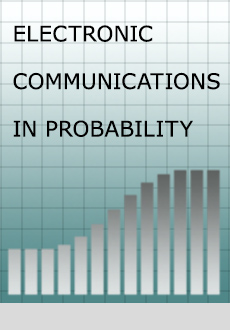Abstract
In the loop $O(n)$ model a collection of mutually-disjoint self-avoiding loops is drawn at random on a finite domain of a lattice with probability proportional to \[\lambda ^{ \# \mbox{ edges} } n^{ \# \mbox{ loops} },\] where $\lambda , n \in [0, \infty )$. Let $\mu $ be the connective constant of the lattice and, for any $n \in [0, \infty )$, let $\lambda _c(n)$ be the largest value of $\lambda $ such that the loop length admits uniformly bounded exponential moments. It is not difficult to prove that $\lambda _c(n) =1/\mu $ when $n=0$ (in this case the model corresponds to the self-avoiding walk) and that for any $n \geq 0$, $\lambda _c(n) \geq 1/\mu $. In this note we prove that, \[ \lambda _c(n) > 1/\mu \, \, \, \, \forall n >0, \] \[\lambda _c(n) \geq 1/\mu \, + \, c_0 \, n \, + \, O(n^2) \, \, \mbox{ as $n \rightarrow 0$,} \] on $\mathbb{Z} ^d$, with $d \geq 2$, and on the hexagonal lattice, where $c_0>0$. This means that, when $n$ is positive (even arbitrarily small), as a consequence of the mutual repulsion between the loops, a phase transition can only occur at a strictly larger critical threshold than in the self-avoiding walk.
Citation
Lorenzo Taggi. "Shifted critical threshold in the loop $ \boldsymbol{O(n)} $ model at arbitrarily small $n$." Electron. Commun. Probab. 23 1 - 9, 2018. https://doi.org/10.1214/18-ECP189
Information





